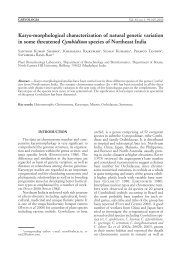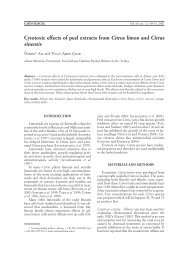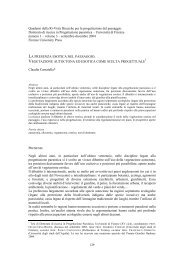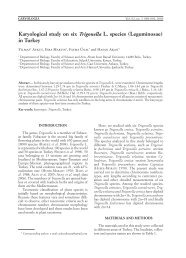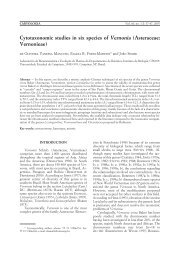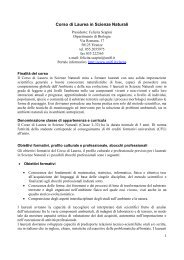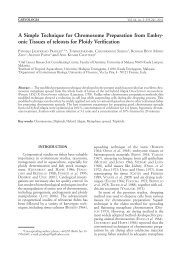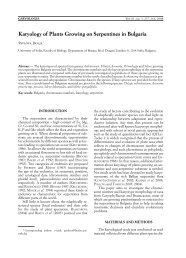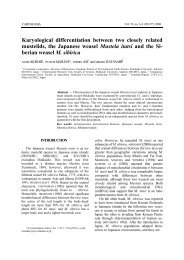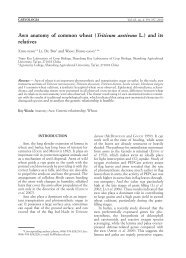Prototulbaghia, a new genus of the Alliaceae family from the Leolo ...
Prototulbaghia, a new genus of the Alliaceae family from the Leolo ...
Prototulbaghia, a new genus of the Alliaceae family from the Leolo ...
You also want an ePaper? Increase the reach of your titles
YUMPU automatically turns print PDFs into web optimized ePapers that Google loves.
CARYOLOGIA Vol. 60, no. 3: 273-278, 2007<br />
<strong>Prototulbaghia</strong>, a <strong>new</strong> <strong>genus</strong> <strong>of</strong> <strong>the</strong> <strong>Alliaceae</strong> <strong>family</strong> <strong>from</strong> <strong>the</strong><br />
<strong>Leolo</strong> Mountains in Sekhukhuneland, South Africa<br />
Vosa* Canio Giuseppe<br />
Linacre College, Oxford<br />
Abstract —A<strong>new</strong> monotypic <strong>genus</strong> <strong>of</strong> <strong>the</strong> <strong>Alliaceae</strong> <strong>family</strong>, <strong>Prototulbaghia</strong>, endemic <strong>of</strong> an isolated range <strong>of</strong> mountains<br />
in N.E. South Africa, is described and illustrated.<br />
Key words: <strong>family</strong> <strong>Alliaceae</strong>, Monotypic <strong>genus</strong>, <strong>Prototulbaghia</strong>.<br />
INTRODUCTION<br />
The existence <strong>of</strong> <strong>the</strong> taxon which is <strong>the</strong> object<br />
<strong>of</strong> <strong>the</strong> present study has been in <strong>the</strong> public domain<br />
for a very long time. Its existence was announced<br />
by Van Wyk and Smith, with photographs,<br />
showing <strong>the</strong> flowering plant in situ,in<strong>the</strong> valuable<br />
book: Regions <strong>of</strong> Floristic Endemisms in Sou<strong>the</strong>rn<br />
Africa (2001). Its ecology and habitat has been described<br />
by Craib & Siebert (2002) again with<br />
photograph <strong>of</strong> <strong>the</strong> habitat and <strong>of</strong> <strong>the</strong> flower. Seeds<br />
are freely available for sale on at least two seed<br />
merchants internet sites and <strong>the</strong> plant is widely<br />
cultivated by bulbous plant collectors.<br />
The present study is to formally describe <strong>the</strong><br />
<strong>new</strong> taxon with notes on its geographical position,<br />
its ecology, cytology and relationship both morphological<br />
and cytological with o<strong>the</strong>r members <strong>of</strong><br />
<strong>the</strong> same <strong>family</strong>.<br />
The geographical and climatological position - The<br />
<strong>Leolo</strong> Mountains, where <strong>the</strong> <strong>new</strong> taxon is to be<br />
found, are located in <strong>the</strong> Sekhukhuneland region,<br />
which lies within <strong>the</strong> Limpopo and Mpumalanga<br />
Provinces <strong>of</strong> Nor<strong>the</strong>rn South Africa, in <strong>the</strong> former<br />
black homeland <strong>of</strong> Lebowa, and are a recognized<br />
Centre <strong>of</strong> Floristic Endemism (van Wyk and<br />
Smith 2001).<br />
The range has a north to south orientation<br />
somewhat parallel to <strong>the</strong> north-eastern Drakensberg<br />
Escarpment and climatically is in its rain<br />
shadow. The major part <strong>of</strong> Sekhukhuneland is hot<br />
* Corresponding author: Dipartimento di Biologia, Via<br />
Luca Ghini, 56126 - Pisa (Italy); e-mail caniovosa@tin.it<br />
and dry but <strong>the</strong> <strong>Leolo</strong> range, which arrives at 1932<br />
m above sea level, raises more than 1000 m above<br />
<strong>the</strong> arid and hot valleys, receiving <strong>the</strong> highest rainfall<br />
<strong>of</strong> <strong>the</strong> area <strong>from</strong> November/December to<br />
April.<br />
Toge<strong>the</strong>r with <strong>the</strong> mist, which is quite common<br />
especially on <strong>the</strong> summit <strong>of</strong> <strong>the</strong> <strong>Leolo</strong> Mountains,<br />
this climatic regime ensures <strong>the</strong> existence<br />
and <strong>the</strong> evolution <strong>of</strong> a diverse flora rich in endemics<br />
(Siebert 1998; van Wyk and Smith 2001;<br />
Siebert et al. 2002).<br />
The existence <strong>of</strong> a number <strong>of</strong> sites <strong>of</strong> open-cast<br />
minings and o<strong>the</strong>r deleterious human activities,<br />
such as heavy grazing, undermines <strong>the</strong> biodiversity<br />
<strong>of</strong> <strong>the</strong> special flora and fauna <strong>of</strong> <strong>the</strong> <strong>Leolo</strong><br />
Mountain Range, to such an extent that drastic<br />
measures <strong>of</strong> conservation are urgent and necessary.<br />
The plant belonging to <strong>the</strong> <strong>new</strong> taxon has been<br />
found so far only in <strong>the</strong> south <strong>of</strong> <strong>the</strong> range on <strong>the</strong><br />
summit plateau, in seepage areas formed between<br />
sheets <strong>of</strong> exposed norite rock, in soil derived <strong>from</strong><br />
its erosion, at an altitude <strong>of</strong> more than 1800 m.<br />
above sea level. Such areas may be quite parched<br />
during <strong>the</strong> dry winter but in <strong>the</strong> rainy season, in<br />
<strong>the</strong> summer, <strong>the</strong>y are more or less permanently<br />
wet, if not saturated in certain periods.<br />
This alternation <strong>of</strong> very dry and wet periods is<br />
proper <strong>of</strong> certain desert or semidesert regions.<br />
The discovery and <strong>the</strong> first collection <strong>of</strong> <strong>the</strong> <strong>new</strong><br />
species was made by Dr. Stefan Siebert in December<br />
1999. Stefan brilliantly conducted <strong>the</strong><br />
first comprehensive floristic-ecological study <strong>of</strong><br />
Sekhukhuneland and collected material <strong>of</strong> several<br />
<strong>new</strong> plant taxa endemic to <strong>the</strong> region (Siebert<br />
1998).
274 vosa canio giuseppe<br />
MATERIALS AND METHODS<br />
The material consisted in a number <strong>of</strong> growing<br />
plants <strong>from</strong> tiny seedlings to mature specimens,<br />
mostly collected “in situ” in two different locations,<br />
and also <strong>from</strong> plants grown <strong>from</strong> seeds obtained<br />
<strong>from</strong> a commercial source in November<br />
2005. They were cultivated in clay pots in a compost<br />
<strong>of</strong> peat, sand and ordinary garden soil and<br />
kept in a cold greenhouse.<br />
For <strong>the</strong> mitotic preparations, actively growing<br />
root-tips, collected at about 11 o’clock a.m., were<br />
pretreated in an aqueous solution <strong>of</strong> 0,05% colchicine<br />
for four hours at <strong>the</strong> same temperature <strong>of</strong><br />
<strong>the</strong> growing plants and fixed overnight in 1:3 glacial<br />
acetic-acid/absolute alcohol. After a short hydrolysis<br />
in 1N hydrochloric-acid at 60°C, <strong>the</strong> meristematic<br />
part <strong>of</strong> <strong>the</strong> tip was squashed in a drop <strong>of</strong><br />
1.5% orcein in 45% acetic-acid or after 6’ hydrolysis,<br />
<strong>the</strong> tips were stained in Feulgen for 1<br />
hour and squashed in 1.5% acetic-orcein.<br />
Photographs <strong>of</strong> <strong>the</strong> living material and <strong>of</strong> <strong>the</strong><br />
cytological preparations, were taken with a digital<br />
camera. They are grouped toge<strong>the</strong>r in Plate I.<br />
RESULTS AND DISCUSSION<br />
Descriptive notes - The <strong>new</strong> taxon is a very small<br />
deciduous plant (Fig. 1) with an alliaceous smell<br />
when crushed and very thin, shiny, dark green<br />
leaves with peculiar hooked tips (Fig. 3). The<br />
emerging young leaves have coils which gradually<br />
relax but remain as thickened hooks on <strong>the</strong> mature<br />
leaves. This feature, owing to <strong>the</strong> plants<br />
growing in more or less loose soil, might be relevant<br />
to a kind <strong>of</strong> asexual propagation, especially<br />
at <strong>the</strong> young seedling stage.<br />
The flowers (Figs. 1 and 2), which face upwards<br />
showing <strong>the</strong> deep yellow an<strong>the</strong>rs, appear<br />
just after <strong>the</strong> start <strong>of</strong> <strong>the</strong> summer rains, usually in<br />
November, and are quite small, <strong>from</strong> 5 to a maximum<br />
<strong>of</strong> 6-7 mm in length <strong>from</strong> <strong>the</strong> tips <strong>of</strong> <strong>the</strong><br />
outer perianth segments to <strong>the</strong> pedicels. They are<br />
white in colour with <strong>of</strong>ten a pink or purplish tinge<br />
on <strong>the</strong> outside and especially on <strong>the</strong> keel <strong>of</strong> <strong>the</strong><br />
outer perianth segments and last only one day.<br />
The flowers usually open in <strong>the</strong> morning, never<br />
fully opening, remaining somewhat campanulate<br />
and fading to deep pink to magenta in colourin<br />
<strong>the</strong> late afternoon (Fig. 4). When a plant starts<br />
flowering, at least in cultivation, <strong>the</strong>re will be at<br />
least one flower open every day for about a week<br />
to ten days. There is <strong>the</strong>n a period <strong>of</strong> rest lasting a<br />
few days and <strong>the</strong> plant starts flowering again.<br />
The flowering season may last all summer. In<br />
<strong>the</strong> wild, <strong>the</strong> <strong>new</strong> taxon appears to produce a large<br />
number <strong>of</strong> seed capsules pointing, perhaps, to a<br />
certain degree <strong>of</strong> self-fertility. The character <strong>of</strong> dimorphic<br />
winged staminal filaments is common in<br />
<strong>the</strong> <strong>family</strong> <strong>Alliaceae</strong> especially in <strong>the</strong> <strong>genus</strong> Allium<br />
and also in some <strong>of</strong> <strong>the</strong> related American genera.<br />
The similarities <strong>of</strong> <strong>the</strong> <strong>new</strong> <strong>genus</strong> with Allium, in a<br />
way, may be tentatively interpreted as it being a<br />
kind <strong>of</strong> a relic, intermediate between <strong>the</strong> latter<br />
and Tulbaghia, making it a sort <strong>of</strong> transitional<br />
stage between <strong>the</strong> two genera. In any case, <strong>the</strong><br />
large size <strong>of</strong> <strong>the</strong> membranaceous expanded dorsal<br />
wings <strong>of</strong> three <strong>of</strong> <strong>the</strong> staminal filaments, which<br />
may be termed petaloid and coalesce at <strong>the</strong> edge<br />
with <strong>the</strong> three o<strong>the</strong>r simple filaments, forming a<br />
pseudo-corona and o<strong>the</strong>r characteristics are peculiar<br />
<strong>of</strong> our <strong>new</strong> <strong>genus</strong>.<br />
Throughout its distribution area on <strong>the</strong> <strong>Leolo</strong>’s<br />
Mountains Range, <strong>the</strong> <strong>new</strong> taxon seems to<br />
show hardly any variability. This lack <strong>of</strong> variability<br />
may be due to its apparent status <strong>of</strong> a paleo-endemic<br />
entity, now restricted to a homogeneous<br />
environment <strong>of</strong> seepage areas at relatively high altitude<br />
(Stefan Siebert 2006, in litteris).<br />
Ecology and distribution -Itisaltoge<strong>the</strong>r intriguing<br />
and provocative to consider <strong>the</strong> existence in<br />
Sou<strong>the</strong>rn Africa <strong>of</strong> a monotypic <strong>genus</strong> cognate to<br />
Tulbaghia and we can exclude <strong>the</strong> possibility <strong>of</strong> an<br />
accidental introduction on <strong>the</strong> line <strong>of</strong> some weedy<br />
species <strong>of</strong> Nothoscordum, notably N. borbonicum,<br />
<strong>of</strong> South American origins.<br />
In this context, it is perhaps pertinent to consider<br />
<strong>the</strong> history <strong>of</strong> human settlements and activities<br />
in <strong>the</strong> area where our entity is found about 20<br />
square kilometres (Craig and Siebert 2002, personal<br />
communication).<br />
Although <strong>the</strong> region is inhabited by <strong>the</strong> mainly<br />
herders and pastoral Pedi tribe, it is never<strong>the</strong>less<br />
known that very few black people have ever lived<br />
permanently in, or near to, <strong>the</strong> area <strong>of</strong> distribution<br />
<strong>of</strong> <strong>the</strong> <strong>new</strong> <strong>genus</strong>. What is really a mistery is why<br />
<strong>the</strong> taxon in question, which is very conspicuous<br />
when its dense stands are in full bloom in November-December,<br />
has not been noticed or collected<br />
before 1999. Thus, given that its white-pinkish<br />
flowers facing upwards showing <strong>the</strong> bright yellow<br />
an<strong>the</strong>rs are quite apparent, it is altoge<strong>the</strong>r strange<br />
that, to <strong>the</strong> best <strong>of</strong> our knowledge, <strong>the</strong>re seem not<br />
to exist any previous record <strong>of</strong> observation nor <strong>of</strong><br />
collection <strong>of</strong> <strong>the</strong> plant under whichever name.<br />
Perhaps, <strong>the</strong> following hypo<strong>the</strong>tical scenarios<br />
may have played a role in <strong>the</strong> plant being overlooked<br />
by field botanists, very few <strong>of</strong> whom, in
prototulbaghia,a<strong>new</strong> <strong>genus</strong> <strong>of</strong> <strong>the</strong> alliaceae <strong>family</strong> <strong>from</strong> <strong>the</strong> leolo mountains in sekhukhuneland 275<br />
Fig. 1 — Inflorescence <strong>of</strong> <strong>Prototulbaghia</strong> siebertii (x 2). Fig. 2. Close-up <strong>of</strong> <strong>the</strong> flowers <strong>of</strong> P. siebertii (x 4). Fig. 3. The<br />
peculiar hooked leaves <strong>of</strong> <strong>the</strong> <strong>new</strong> <strong>genus</strong> (x 2). Fig. 4. The deep pink colour <strong>of</strong> <strong>the</strong> fading flowers in P. siebertii. Note<br />
<strong>the</strong> light green “calyx” and <strong>the</strong> greenish stripe which mark <strong>the</strong> keel <strong>of</strong> <strong>the</strong> outer perianth segments <strong>of</strong> <strong>the</strong> unopened<br />
flowers (x 4). Fig. 5. Mitotic metaphase in P. siebertii (2n= 2x= 12). The nucleolar constrictions (arrows) are located<br />
distally on <strong>the</strong> short arm <strong>of</strong> <strong>the</strong> smallest chromosomes <strong>of</strong> <strong>the</strong> complement. They are just visible as filaments connecting<br />
<strong>the</strong> short arm with <strong>the</strong> small “satellites” (x 2740). Figs.2 and 4 courtesy <strong>of</strong> Dirk Wallace.
276 vosa canio giuseppe<br />
any case, seem to have visited <strong>the</strong> top <strong>of</strong> <strong>the</strong> <strong>Leolo</strong><br />
Mountains prior to 1999. 1 -Afactor to be considered<br />
is that Sekhukhuneland lies in <strong>the</strong> former<br />
black homeland <strong>of</strong> Lebowa and that, even in <strong>the</strong><br />
comparatively recent past, hardly any botanist<br />
ever visited <strong>the</strong> area. 2 - The flowering time <strong>of</strong> <strong>the</strong><br />
<strong>new</strong> taxon coincides with that <strong>of</strong> Zantedeschia jucunda<br />
(Araceae), a rare Arum Lily with very<br />
showy yellow inflorescences which is also endemic<br />
to <strong>the</strong> summit plateau <strong>of</strong> <strong>the</strong> <strong>Leolo</strong> Mountains.<br />
It is possible that <strong>the</strong> attention <strong>of</strong> visiting<br />
botanists were so distracted by this spectacular<br />
plant, that <strong>the</strong> comparatively less showy and more<br />
localized stands <strong>of</strong> our taxon were overlooked. 3 -<br />
The confinement <strong>of</strong> <strong>the</strong> <strong>new</strong> taxon to temporary<br />
seepage areas may indeed result in irregular flowering.<br />
In fact, <strong>the</strong> first collection was made after<br />
particularly good spring rains and perhaps <strong>the</strong> occasional<br />
availability <strong>of</strong> abundant moisture explains<br />
<strong>the</strong> abundant flowering <strong>of</strong> <strong>the</strong> species at <strong>the</strong><br />
time <strong>of</strong> discovery. During dry seasons, which in<br />
<strong>the</strong> area are more common that wet ones, plants<br />
may flower more erratically, thus rendering <strong>the</strong>m<br />
much less conspicuous. 4 - Ano<strong>the</strong>r, perhaps less<br />
likely explanation, might be a rapid expansion <strong>of</strong><br />
<strong>the</strong> size <strong>of</strong> <strong>the</strong> populations owing to some kind <strong>of</strong><br />
recent environmental changes. Such changes may<br />
imply a drastic reduction in number or <strong>of</strong> <strong>the</strong> disappearance<br />
<strong>of</strong> serious competitors or predators<br />
or <strong>the</strong> sudden appearance <strong>of</strong> a more efficient pollinator.<br />
Differences, similarities and parallelisms - It is certain<br />
that <strong>the</strong>re are some important morphological<br />
differences between our plant and Tulbaghia.<br />
These differences involve <strong>the</strong> existence, in all species<br />
<strong>of</strong> Tulbaghia, <strong>of</strong>aperigonial tube and <strong>of</strong> a<br />
true, <strong>of</strong>ten quite fleshy corona formed, in <strong>the</strong> light<br />
<strong>of</strong> our findings in <strong>the</strong> <strong>new</strong> taxon, by a morphological<br />
evolution <strong>of</strong> <strong>the</strong> staminal filaments, toge<strong>the</strong>r<br />
with an outgrowth <strong>of</strong> <strong>the</strong> perianth. O<strong>the</strong>r differences<br />
are to be found in <strong>the</strong> position <strong>of</strong> <strong>the</strong> an<strong>the</strong>rs<br />
in two whorls, one inside <strong>the</strong> perigonial tube<br />
at <strong>the</strong> level or just above <strong>the</strong> stigma and <strong>the</strong> o<strong>the</strong>r<br />
more or less near <strong>the</strong> mouth <strong>of</strong> <strong>the</strong> corona in Tulbaghia<br />
while, in <strong>the</strong> <strong>new</strong> taxon, where <strong>the</strong> perigonial<br />
tube is very much reduced and insignificant,<br />
<strong>the</strong> an<strong>the</strong>rs are all at <strong>the</strong> same level or just protruding,<br />
toge<strong>the</strong>r with <strong>the</strong> stigma, <strong>from</strong> <strong>the</strong> top <strong>of</strong><br />
<strong>the</strong> coalescing filaments which form a kind <strong>of</strong><br />
pseudo-corona.<br />
These morphological differences neatly separate<br />
our taxon <strong>from</strong> Tulbaghia, hence <strong>the</strong> proposal<br />
<strong>of</strong> a <strong>new</strong> <strong>genus</strong>.<br />
On <strong>the</strong> basis <strong>of</strong> our findings, we opine that <strong>the</strong><br />
kind <strong>of</strong> staminal structure found in our <strong>new</strong> <strong>genus</strong><br />
is a possible intermediate stage towards a proper<br />
fleshy corona as in Tulbaghia. There remains <strong>the</strong><br />
interesting problem <strong>of</strong> <strong>the</strong> peculiar ecological and<br />
taxonomic position <strong>of</strong> <strong>the</strong> proposed <strong>new</strong> <strong>genus</strong>.<br />
These peculiarities may perhaps warrant <strong>the</strong> suggestion<br />
<strong>of</strong> a possible reverse trend as an alternative<br />
hypo<strong>the</strong>sis to its morphological evolution.<br />
Thus, taking into account this trend, we can envisage<br />
<strong>the</strong> reduction, due a strong selective pressure,<br />
<strong>from</strong> <strong>the</strong> usually fleshy corona <strong>of</strong> Tulbaghia, into<br />
<strong>the</strong> elaborate staminal structure <strong>of</strong> <strong>the</strong> <strong>new</strong> taxon.<br />
Therefore, we may consider, as adaptive characters,<br />
<strong>the</strong> elongation <strong>of</strong> <strong>the</strong> coalescing petaloid and<br />
simple staminal filaments, forming a kind <strong>of</strong><br />
pseudo-corona, and <strong>the</strong> protrusion <strong>of</strong> <strong>the</strong> an<strong>the</strong>rs<br />
at <strong>the</strong> same level <strong>of</strong> <strong>the</strong> stigma, toge<strong>the</strong>r with <strong>the</strong><br />
characteristic upward facing flowers <strong>of</strong> our <strong>new</strong><br />
taxon. Such complex adaptive characters must be<br />
related to <strong>the</strong> special ecological situation in which<br />
our taxon has evolved in isolation and may involve<br />
<strong>the</strong> existence <strong>of</strong> an endemic co-evolved pollinator.<br />
Of course, <strong>the</strong> acceptance <strong>of</strong> <strong>the</strong> hypo<strong>the</strong>sis <strong>of</strong><br />
a reverse trend signifies <strong>the</strong> complete overturning<br />
<strong>of</strong> our erstwhile speculations that consider <strong>the</strong><br />
<strong>Leolo</strong> Mountains taxon a precursor <strong>of</strong> Tulbaghia<br />
and, instead, would make it a later derivative. This<br />
interpretation, in spite <strong>of</strong> <strong>the</strong> diverging floral characters,<br />
would place <strong>the</strong> entity in question taxonomically<br />
and philogenetically clearly within <strong>the</strong><br />
<strong>genus</strong> Tulbaghia. In any case, though, <strong>the</strong> results<br />
<strong>of</strong> our studies, both morphological and cytotaxonomical,<br />
have led us to consider and put forward,<br />
as <strong>the</strong> most probable, <strong>the</strong> first hypo<strong>the</strong>sis <strong>of</strong> a precursor<br />
<strong>of</strong> Tulbaghia for <strong>the</strong> <strong>Leolo</strong> Mountains<br />
plant.<br />
Accordingly, we hypo<strong>the</strong>size that <strong>the</strong> existence<br />
<strong>of</strong> a precursor <strong>of</strong> Tulbaghia, indigenous <strong>of</strong><br />
<strong>the</strong> <strong>Leolo</strong> Mountains Range in Sekhukhuneland,<br />
is altoge<strong>the</strong>r reasonable, especially if we take into<br />
account, besides <strong>the</strong> morphological details, chromosome<br />
number and morphology (Fig. 5).<br />
The chromosome complement <strong>of</strong> <strong>the</strong> <strong>new</strong><br />
taxon is similar to that <strong>of</strong> Group 5 <strong>of</strong> Tulbaghia<br />
(Vosa 1975; 2000) which includes five species: T.<br />
leucantha, T. natalensis, T. verdoorniae, T. coddii<br />
and T. galpinii. This latter species is morphologically<br />
peculiar and represents a special case which<br />
may be important in our effort to understand <strong>the</strong><br />
isolated existence <strong>of</strong> <strong>the</strong> <strong>new</strong> taxon.<br />
T. galpinii, unlike any o<strong>the</strong>r known species <strong>of</strong><br />
Tulbaghia, possesses a corona composed <strong>of</strong> three<br />
scarcely fleshy main lobes, each subdivided, about<br />
half <strong>of</strong> <strong>the</strong>ir length, into two smaller acuminate
prototulbaghia,a<strong>new</strong> <strong>genus</strong> <strong>of</strong> <strong>the</strong> alliaceae <strong>family</strong> <strong>from</strong> <strong>the</strong> leolo mountains in sekhukhuneland 277<br />
lobes. T. galpinii is a very small plant with ra<strong>the</strong>r<br />
thin leaves, found only in a few very restricted areas<br />
<strong>of</strong> <strong>the</strong> Eastern Cape and all accessible living<br />
and herbarium collections are remarkably uniform.<br />
It is found in a homogeneous environment<br />
<strong>of</strong> sandy soil in rocky areas, <strong>of</strong>ten associated with<br />
dwarf clumpy euphorbias which provide a kind <strong>of</strong><br />
protection <strong>from</strong> herbivores. Experiments on cultivated<br />
material, originally collected in four separate<br />
locations in its area <strong>of</strong> distribution, carried<br />
out over several years, have established that T.<br />
galpinii is almost completely self-fertile. This character,<br />
which involves inbreeding, has placed this<br />
species into an evolutionary cul-de-sac. This, <strong>of</strong><br />
course, might account for <strong>the</strong> “primitive” features<br />
such as <strong>the</strong> thin and deeply lobed corona.<br />
T. galpinii has a short perigonial tube and<br />
seems not to have any morphologically close relatives.<br />
The relatively small area <strong>of</strong> distribution indicates<br />
that this species may be at <strong>the</strong> end <strong>of</strong> a nearly<br />
estinct evolutionary trend. The parallel with <strong>the</strong><br />
<strong>new</strong> taxon is evident: similar karyotype, very restricted<br />
distribution, a peculiar ‘corona’, a short<br />
perigonial tube and is supported by <strong>the</strong> study <strong>of</strong><br />
karyotype evolution in Tulbaghia (Vosa 1975;<br />
2000).<br />
I take pleasure in naming <strong>the</strong> <strong>new</strong> taxon after<br />
its discoverer, Dr. Stefan Siebert, in recogniuion<br />
<strong>of</strong> his considerable contribution to <strong>the</strong> botany and<br />
ecology <strong>of</strong> <strong>the</strong> Sekhukhuneland Centre <strong>of</strong> Floristic<br />
Endemism (Siebert 1998).<br />
TYPIFICATION<br />
<strong>Prototulbaghia</strong> siebertii gen. et sp. nov.<br />
Chromosomatum numerus: 2n=2x= 12<br />
Diagnosis - Planta pusilla, speciebus generis Tulbaghiae<br />
affinis a quibus tamen precipue differt foliis<br />
apice revolutis et tubus ex perigonii nullus per filamentis<br />
contiguis coronam similantibus.<br />
Descriptio - Planta bulbo conico rhizomati brevissimo<br />
insidente, circa 15 mm diametro, ad 25 mm<br />
longo, tunicis membranaceis lilacinis obtecto. Radices<br />
parce carnosae. Foliia 3-6 erecto-patentia,<br />
nitida, atro-viridia, 10-15 cm longa, 1-1,5 mm lata,<br />
acuta apice revoluta. Scapus gracilis, foliis aequilongis<br />
vel iis paulo brevior, 3-8 florus. Bracteae<br />
membranaceae, atro-purpureae, sub an<strong>the</strong>sis scariosae.<br />
Flores erecti, tepala alba in 2 verticilli disposita,<br />
inferne adnata in calix hemisphaericus 1,5<br />
mm longo, superne libera, marginibus dilute purpureis;<br />
terna verticilli inferioris oblonga, 4 mm<br />
longa, 2 mm lata, carinata, carina dilute purpurea,<br />
superne striata nervo mediano viridi vel dilute purpureo;<br />
terna verticilli superiora oblonga, 3,5 mm<br />
longa, ad 1,7 mm lata, superne striata nervo mediano,<br />
viridi vel dilute purpureo. Stamina in 2 verticilli<br />
disposita, filamentis contiguis corona simulantibus,<br />
difformibus, ternis verticilli inferioris laminaribus<br />
petaloideis, eroso-obtusis, ternis verticilli<br />
superioris subfiliformibus; an<strong>the</strong>ris 1 mm longis,<br />
flavis. Ovarium subglobosum, tubo perigoniali partim<br />
adnatum, triloculare, ovulis 2-4 in singulo<br />
loculo. Stylus 3 mm longus, subfiliformis. Stigma<br />
capitatum, minute papillatum, nitens. Capsula<br />
matura mitriformis, loculicida.<br />
Description - Rootstock a bulb-like, elongated,<br />
pear-shaped corm on a very short poorly defined<br />
rhizome, 15 mm in diam. and about 20 to 25 mm<br />
long. Roots not very numerous, a little fleshy.<br />
Leaves3-6erect to spreading, bright green with a<br />
purplish membranaceus base, semiterete, fleshy<br />
with a not very distinct double keel and with a distinctly<br />
acute and hooked apex, 10-15 cm long and<br />
about 1,0 - 1,5 mm broad. Leaves <strong>from</strong> 10 to 15<br />
cm long with <strong>the</strong>ir tips somewhat coiled outwards<br />
when young, <strong>the</strong> coil relaxing as <strong>the</strong> leaf develops<br />
but remaining as a tickened hooked tip in mature<br />
leves. Peculiarly, it is difficult if not impossible,<br />
without uprooting <strong>the</strong>m, to pass a finger through<br />
a clump <strong>of</strong> plants because <strong>of</strong> <strong>the</strong> entangled<br />
hooked leaf-tips. Spa<strong>the</strong> valves 2, <strong>the</strong> longest<br />
about 4 mm long, purplish-brown in colour, scariose<br />
at an<strong>the</strong>sis, sub-tending <strong>the</strong> inflorescence only<br />
at <strong>the</strong> emergence <strong>of</strong> <strong>the</strong> flower-scape <strong>the</strong>n gradually<br />
drying out. Floral scape thin, as long or a little<br />
shorter than <strong>the</strong> leaves, carrying 2 to 4 flowers.<br />
Pedicels about 7 mm long, usually greenish-purple<br />
in colour. Flowers facing upwards, about 5,5 -<br />
7mmlong overall, developing and opening in<br />
succession over a few days, never fully opening<br />
and remaining somewhat bell-shaped with <strong>the</strong><br />
outer segments flaring out ra<strong>the</strong>r more than <strong>the</strong><br />
inner, opening about mid morning in bright sunshine<br />
and closing early in <strong>the</strong> afternoon, each<br />
flower lasting only one day, eventually fading pink<br />
to magenta as <strong>the</strong>y age and close. Perianth segments<br />
connate for about 2 mm in <strong>the</strong>ir lower half<br />
forming a very short and scarcely evident light<br />
green calyx, outer segments about 4,5 mm long<br />
and 2 mm wide in <strong>the</strong>ir upper third, pinkish towards<br />
<strong>the</strong> tip at an<strong>the</strong>sis, gradually fading into<br />
white, spathulate with a well defined keel purplish<br />
towards <strong>the</strong> end and with a light pink mid-vein on<br />
<strong>the</strong> inside, inner segments about broadly oblongovate,<br />
spathulate, a little shorter than <strong>the</strong> outers
278 vosa canio giuseppe<br />
and about 1,5 mm wide about <strong>the</strong>ir middle, greenish-hyaline<br />
in colour with a faint green mid-vein.<br />
Staminal filaments 6, <strong>the</strong> three originating at <strong>the</strong><br />
base <strong>of</strong> <strong>the</strong> inner perianth segments greatly dilated<br />
into oblong retuse-erose petaloid wings on <strong>the</strong>ir<br />
outward sides, <strong>the</strong> three facing <strong>the</strong> outer perianth<br />
segments thread-like, fused to <strong>the</strong> hedges <strong>of</strong> <strong>the</strong><br />
petaloid filaments for little more than half <strong>of</strong> <strong>the</strong>ir<br />
length. Thus, <strong>the</strong> six filaments toge<strong>the</strong>r form what<br />
appears as a cylindrical pseudo-corona. An<strong>the</strong>rs<br />
bright yellow, sagittate, about 1,5 mm long and<br />
0,3 mm wide, attached to <strong>the</strong> tips <strong>of</strong> <strong>the</strong> threadlike<br />
filaments and about <strong>the</strong> middle <strong>of</strong> <strong>the</strong> petaloid<br />
wings on a short filaments, <strong>the</strong>ir tips showing<br />
at <strong>the</strong> level or just above <strong>the</strong> rim <strong>of</strong> <strong>the</strong> pseudo-corona.<br />
Style about 3 mm long, reaching or just<br />
above <strong>the</strong> level <strong>of</strong> <strong>the</strong> dehiscing an<strong>the</strong>rs, ra<strong>the</strong>r<br />
thin. Stigma small, capitate with <strong>the</strong> tip covered<br />
by minute shiny papillae. Ovary about 1 mm long,<br />
shiny green, about as long as <strong>the</strong> calyx formed by<br />
<strong>the</strong> coalescing perianth segments, obovate, triangular<br />
in shape with rounded corners in section.<br />
Ripe capsule triangular, mitre-like with <strong>the</strong> dried<br />
up remains <strong>of</strong> <strong>the</strong> perianth segments at its base<br />
and carrying at its top <strong>the</strong> wi<strong>the</strong>red style.<br />
Holotype: A. E. van Wyk & S. Siebert, 1304<br />
(PRU)! Limpopo - 2430 CA (Pilgrim’s Rest):<br />
<strong>Leolo</strong> Mountains, Sekhukhuneland, ca. 15 Km<br />
<strong>from</strong> Schoonoord on mountain road. Growing in<br />
seepage areas <strong>of</strong> grassland in poorly drained soil<br />
overlying norite rock, in full sun in a gentle northfacing<br />
slope (04/12/2000).<br />
O<strong>the</strong>r material seen:<br />
a) - A. E. van Wyk, 13577 (PRU), Limpopo -<br />
2430 CA (Pilgrim’s Rest): <strong>Leolo</strong> Mountains,<br />
Sekhukhuneland, summit area near Maope.<br />
Growing in seepage areas associated with exposed<br />
rock sheets (11/12/2000).<br />
b) - A. E. van Wyk, 13581 (PRU), Limpopo -<br />
2430 CA (Pilgrim’s Rest): <strong>Leolo</strong> Mountains,<br />
Sekhukhuneland, summit area near Maope, grow-<br />
ing in heavily grazed grassland in seepage areas associated<br />
with exposed rock sheets (11/12/2000).<br />
The holotype and <strong>the</strong> o<strong>the</strong>r specimens are<br />
kept in <strong>the</strong> H.G.W.J. Schweickerdt Herbarium<br />
(PRU), Botany Department, University <strong>of</strong> Pretoria,<br />
South Africa.<br />
Acknowledgements —Iwish to thank all <strong>the</strong> people<br />
in South Africa and especially <strong>the</strong> staff <strong>of</strong> <strong>the</strong> South<br />
African Biodiversity Institute (S.A.N.B.I.) for <strong>the</strong>ir kind<br />
assistance and hospitality during my visit to <strong>the</strong> National<br />
Herbarioum in Pretoria. I wish to express my<br />
deep gratitude to <strong>the</strong> Curator <strong>of</strong> <strong>the</strong> H.G.W.J. Schweickerdt<br />
Herbarium <strong>of</strong> <strong>the</strong> Botany Department <strong>of</strong> <strong>the</strong><br />
University <strong>of</strong> Pretoria, for assistance during my stay in<br />
South Africa. I wish to thank also Dr. R. M. Baldini <strong>of</strong><br />
Florence, Italy, for linguistic collaboration.<br />
REFERENCES<br />
Craib C. and Siebert S., 2002 — A <strong>new</strong> <strong>genus</strong> related<br />
to Tulbaghia <strong>from</strong> seepage areas on <strong>the</strong> summit <strong>of</strong> <strong>the</strong><br />
<strong>Leolo</strong> Mountains in Sekhukhuneland, South Africa.<br />
Herbertia, 57: 85-90.<br />
Siebert S.J., 1998 — Ultramafic substrates and floristic<br />
patterns in Sekhukhuneland, South Africa.<br />
M. Sc. Thesis, University <strong>of</strong> Pretoria, South Africa.<br />
Siebert S.J., Victor J.E., van Wyk A.E. and<br />
Bredenkamp G.J., 2002 — An assessment <strong>of</strong> threatened<br />
plants and conservation in Sekhukhuneland.<br />
Plant Life, 26: 7-18.<br />
Vosa C.G., 1966a — Chromosome variation in Tulbaghia.<br />
Heredity, 21: 305-312.<br />
Vosa C.G., 1966b — Tulbaghia hybrids. Heredity, 21:<br />
675-687.<br />
Vosa C.G., 1975 — The cytotaxonomy <strong>of</strong> <strong>the</strong> <strong>genus</strong> Tulbaghia.<br />
Annali di Botanica (Roma), 34: 47-121.<br />
Vosa C.G., 2000 — A revised cytotaxonomy <strong>of</strong> <strong>the</strong> <strong>genus</strong><br />
Tulbaghia. Caryologia, 53: 82-112.<br />
Wyk A. E. van and Smith G. F., 2001 — Regions <strong>of</strong><br />
Floristic Endemism in Sou<strong>the</strong>rn Africa. Undau<br />
Press, Hatfield, South Africa.<br />
Received February 8 th 2007; accepted April 15 th 2007




